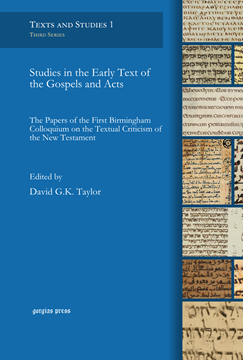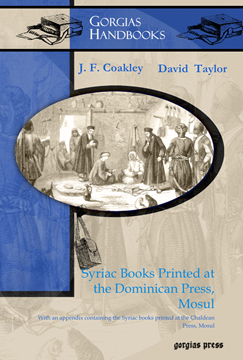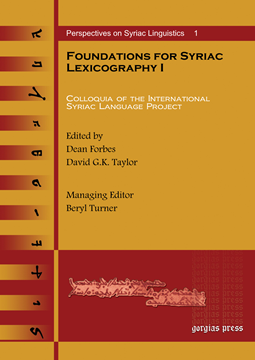David G.K. Taylor

David Taylor is University Lecturer in Aramaic and Syriac at the University of Oxford.
Studies in the Early Text of the Gospels and Acts
The Papers of the First Birmingham Colloquium on the Textual Criticism of the New Testament
Edited by David G.K. Taylor
Series: Texts and Studies (Third Series) 1
ISBN: 978-1-4632-0242-2
Eleven papers from the First Birmingham Colloquium on the Textual Criticism of the New Testament, examining aspects of the Textus Receptus, the ‘Pre-Johannine Text’ of the Gospel, the ratings system in the United Bible Societies’ Greek New Testament and the application of probability theory to textual transmission, as well as surveys of non-continuous papyrus witnesses to the New Testament and the Dura-Europos Gospel Harmony, alongside studies of variation in the form of the Beatitudes and the location of Emmaus.
$157.00 (USD) $94.20 (USD)
Syriac Books Printed at the Dominican Press, Mosul
With an appendix containing the Syriac books printed at the Chaldean Press, Mosul
Series: Gorgias Handbooks 14
ISBN: 978-1-60724-104-1
Since the 1850s until the outbreak of World War I, the Dominican Press in Mosul, Iraq, produced scholarly, liturgical, and pedagogical publications to service the local Christian communities. These hard to find publications have now been cataloged in detail by J. F. Coakley and David G. K. Taylor.
$98.00 (USD) $58.80 (USD)
Foundations for Syriac Lexicography I
Colloquia of the International Syriac Language Project
Edited by Dean Forbes & David G.K. Taylor
Series: Perspectives on Syriac Linguistics 1
ISBN: 1-59333-138-X
This volume is the first in a series of collected essays that addresses issues of Syriac linguistics as they relate to a contemporary approach to lexicography. The international team of authors invited to participate represents a wide range of disciplines and opens new horizons in lexical thinking. Special emphasis is placed on the role that technology has, does, and will play in the evolving field of lexicography.
$145.00 (USD) $87.00 (USD)
The Hidden Pearl (vol. 2)
Vol. 2:
ISBN: 1-931956-99-5-2
Aramaic, the language of Jesus of Nazareth, was the lingua franca of the Middle East for over a thousand years before Arabic became widespread. This volume focuses on the Late Antiquity period and how Syriac Christianity emerges from Jewish Aramaic and the course of these two Aramaic traditions. The second part of this volume focuses on the Syriac tradition and its cultural role, the importance of Syriac scholars, and the spread of Syriac Christianity eastward in the first millennium AD. Includes both color and black and white illustrations.
$50.00 (USD)




